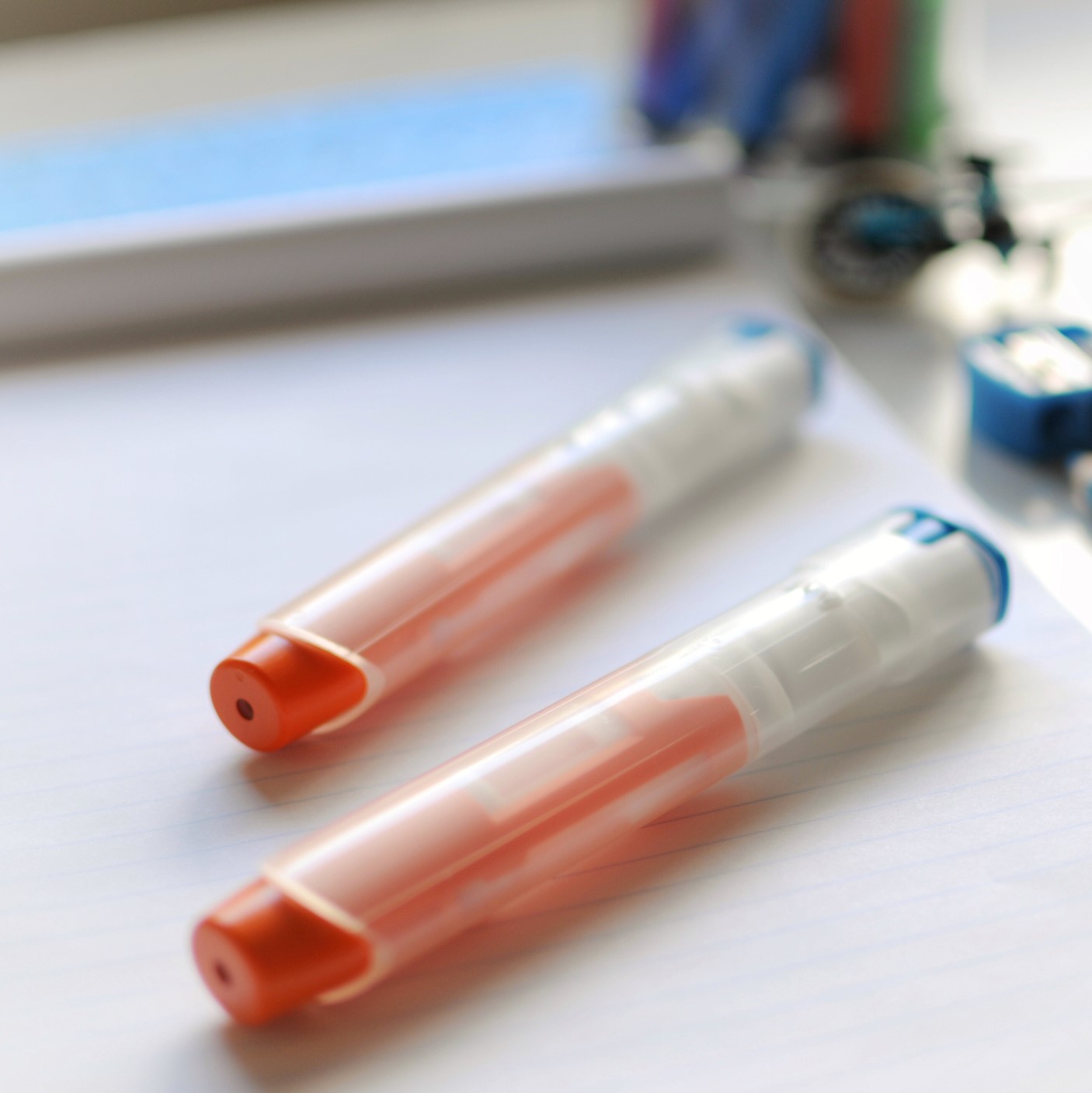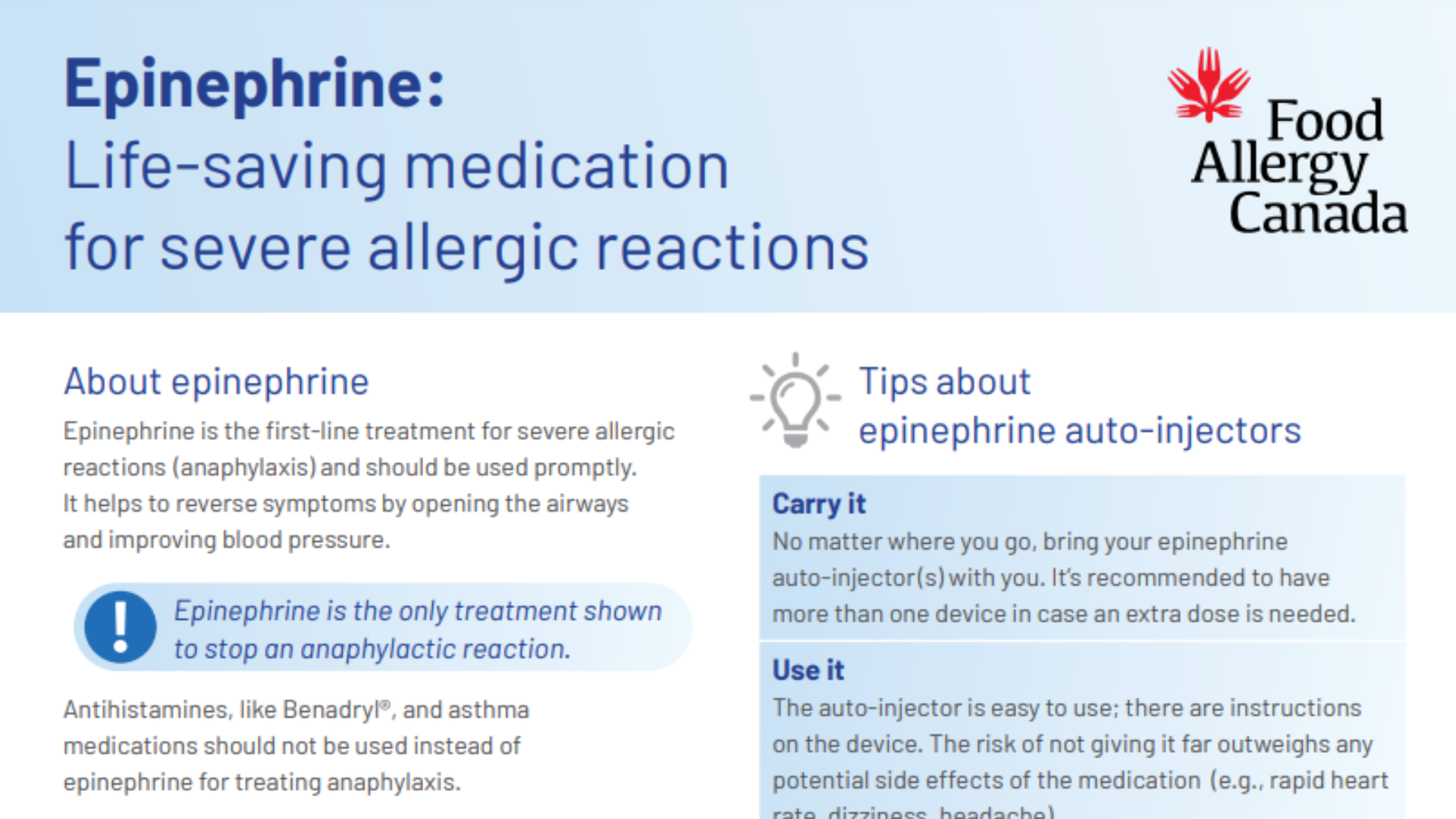Epinephrine is the drug form of a hormone (adrenaline) that the body produces on its own. It helps to reverse symptoms of an allergic reaction by:
- Opening the airways
- Improving blood pressure
- Accelerating heart rate
First-line treatment
Epinephrine is the only drug that can reverse symptoms of anaphylaxis and is considered life-saving medication. Canadian allergists advise that an epinephrine auto-injector (e.g. EpiPen®) is the first line of treatment for anaphylaxis and should be used before asthma inhalers, antihistamines, or any other medications.
If you are uncomfortable or unsure about using an epinephrine auto-injector, discuss your concerns with your healthcare provider. Free training devices are also available to practice using an auto-injector, visit epipen.ca.
- You may feel nervous about using epinephrine but remember – it’s safe to use in normally healthy individuals.
- Epinephrine rarely causes harm, even if given when not needed.
- Possible side effects can include rapid heart rate, paleness, dizziness, weakness, tremors and headache. These side effects are generally mild and go away within a few minutes.
Points to remember about epinephrine
- Even if you or your child have received epinephrine, you still need to go to hospital for observation because further treatment may be needed.
- Many people worry they might mistake anaphylaxis for an asthma attack. If it’s not clear which someone is experiencing, epinephrine should be used first as it can treat the symptoms of both. In the past, epinephrine was used to treat asthma attacks before modern asthma medications were available. Discuss this with your doctor.
- Give other medications, such as asthma drugs and antihistamines, after giving epinephrine.
- Antihistamines can be used to treat hives or skin symptoms, but have not been proven to stop anaphylaxis. You can use antihistamines, after you have used your epinephrine auto-injector.
Importance of epinephrine
Epinephrine is the first line treatment for anaphylaxis, a severe allergic reaction that can be life-threatening.
Watch paediatric allergist, and one of our Healthcare Advisory Board members Dr. Ben-Shoshan and Beatrice, from our team, talk about signs and symptoms, treating reactions, educating others and reading food labels.
Thank you EpiPen® Canada for creating these videos.
Know it. Treat it. campaign
Join the conversation and share how you “Know it. Treat it.” with anaphylaxis.
This campaign is about de-mystifying anaphylaxis and empowering all Canadians to “Know” what the signs and symptoms are and how to “Treat” anaphylaxis. Hear first-hand from Canadians across the country about their anaphylaxis stories and learn from their experiences.
The goal of this campaign is to empower Canadians around recognizing and treating anaphylaxis through real life stories and education.
Protecting your auto-injector
Epinephrine can be damaged by heat and cold, so remember:
• Keep your auto-injector at room temperature (15 – 30°C / 59 – 86°F)
• Do not store it in a car or a fridge.
• In cold weather, keep it inside your child’s coat. In hot weather, keep it in the shade.
About epinephrine
Auto-injector 101

Practical tips for epinephrine auto-injectors.
Keep it up-to-date
Make sure your auto-injector is not expired. You can check the date on the device, or sign up for a free e-mail reminder at epipen.ca.
Take care of it
Epinephrine can lose its effectiveness when stored in extreme heat or cold. Never leave it in a car’s glove box or under a stroller where it can get too hot or too cold. Carry it in an inside coat pocket in winter. In summer, don’t leave it in the hot sun.
Practice using it
You can order a free training device, which contains no needle or drug, from epipen.ca.
Educate
Teach friends, family, co-workers, babysitters, teachers — anyone who needs to know — how to use the auto-injector and where you keep it.
Carry it!
No matter where you go, your auto-injector should be with you. Many families live by the motto “No auto-injector, no food”. There are even apps you can purchase that will help you remember to bring it when you leave home.
Use it
The auto-injector is easy to use, it’s safe and it saves lives. If you have questions about your auto-injector, speak to your allergist or see our Resources section.




